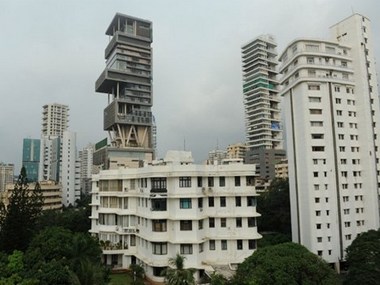Slowest growth in nine years, double-digit inflation, depreciating rupee and a falling market- India’s economic woes are doing little to deter the country’s millionaires. According to the Global Wealth Report 2012 of the Boston Consulting Group (BCG), nearly 28,000 Indian households crossed the threshold to become millionaires in 2011.
While the man on the street continues to wonder when he will be able to buy a modest home of his own, India’s super-rich are raising palatial homes at truly astronomical expenses. As per estimates of Cushman & Wakefield, over 8,000 residential units in the luxury segment are expected to be ready by 2013.
[caption id=“attachment_328835” align=“alignleft” width=“380” caption=“Foreign residents are not allowed to own property in India but many members of the large Indian diaspora are keen to invest in niche homes”]  [/caption]
Antilia, Mukesh Ambani’s 27-floor fortress at Altamount Road in South Mumbai, is one of the most expensive home in the world. Vijay Mallya has levelled his 4.5 acre ancestral home on Vittal Mallya Road in Bangalore to make way for the 82-apartment ‘White House’, in which he will be occupying an acre-sized ‘palace penthouse’ on the 33rd and 34th floors. '
Exclusive new-built homes such as the NCPA Towers and Buckley Court in Mumbai, Laburnum in the upcoming suburb of Gurgaon and Hiranandani Gardens in Powai, Mumbai, are among many others that have triggered the luxury home boom in India," noted a report by Jones Lang LaSalle India. And now the trend is spreading from big metros to cities like Chennai, Pune, Chandigarh etc., too.
But will this premium housing impact property prices for the common man? According to Anuj Puri, Chairman & Country Head, Jones Lang LaSalle India, the homes of the super-rich create an upward pressure on the price tags of luxury and premium homes in the immediate vicinity. However, the real estate market in general is not affected, as these luxury developments represent a minuscule segment of the wider fabric. Ironically, he says for the super luxury segment, a higher ticket size is sometimes valued more as it attaches an esteem value to the property and limits its accessibility to the masses.
India’s global ranking now stands at 13 with the number of millionaire households jumping by nearly 21 percent to 162,000 in 2011 from 134,000 in 2010. US still has the world’s biggest population of millionaire households (51,3 lakh), followed by Japan with 15 lakh households and China at 14.3 lakh.
Anna Zakrzewski, one of the report’s authors, told The Guardian that the world is in the midst of a “tectonic shift” that will see Asia overtake Europe in terms of total wealth within five years. She predicted China will be the third richest nation in terms of private wealth within five years, and India will jump to seventh.
BCG’s study of 130 institutions found that total client assets were little changed last year, compared with an 11 percent gain in 2010, reflecting falling markets and meager inflows. Worldwide growth in private wealth last year climbed just 1.9 percent to $122.8 trillion, compared with a rise of 6.8 percent in 2010 and 9.6 percent in 2009. The bright spot in the global economy continued to be the developing regions of the Asia-Pacific (excluding Japan), Eastern Europe, Latin America and the Middle East and Africa.
BCG estimates that private wealth in India and China will grow at compound annual growth rates of 19 percent and 15 percent, respectively, through 2016, compared with a global growth rate of 4 percent to 5 percent. More than a third of the global increase will come from China alone.


)
)
)
)
)
)
)
)
)



